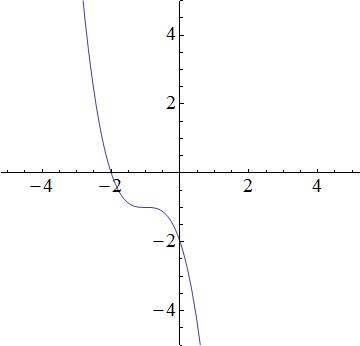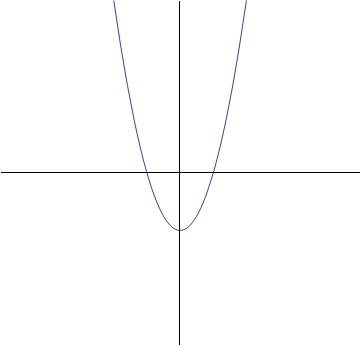All Algebra 1 Resources
Example Questions
Example Question #1 : Functions And Graphs
Which graph depicts a function?
Example Question #3311 : Algebra 1
The graph below is the graph of a piece-wise function in some interval. Identify, in interval notation, the decreasing interval.
As is clear from the graph, in the interval between 









Example Question #1 : Graphing Polynomial Functions
Which equation best represents the following graph?

None of these
We have the following answer choices.
The first equation is a cubic function, which produces a function similar to the graph. The second equation is quadratic and thus, a parabola. The graph does not look like a prabola, so the 2nd equation will be incorrect. The third equation describes a line, but the graph is not linear; the third equation is incorrect. The fourth equation is incorrect because it is an exponential, and the graph is not an exponential. So that leaves the first equation as the best possible choice.
Example Question #31 : Functions And Lines
What is the horizontal asymptote of the graph of the equation 
The asymptote of this equation can be found by observing that 



So the value that 


Example Question #1 : Solving And Graphing Exponential Equations
What is/are the asymptote(s) of the graph of the function


An exponential equation of the form 



Example Question #31 : Functions And Lines
Example Question #1 : How To Graph A Two Step Inequality
Which graph depicts the following inequality?
No real solution.





Let's put the inequality in slope-intercept form to make it easier to graph:
The inequality is now in slope-intercept form. Graph a line with slope 

Because the inequality sign is greater than or equal to, a solid line should be used.
Next, test a point. The origin 
The statement is false. Therefore, the section of the graph that does not contain the origin should be shaded.
Example Question #2 : Quadratic Functions
What is the minimum possible value of the expression below?
The expression has no minimum value.
We can determine the lowest possible value of the expression by finding the 

The vertex of the parabola 

The parabola is concave upward (its quadratic coefficient is positive), so 

Example Question #1 : How To Graph A Quadratic Function
What is the vertex of the function 





The equation of a parabola can be written in vertex form: 
The point 


In this example, 
Example Question #2 : Graphing Polynomial Functions
Which of the graphs best represents the following function?

None of these




The highest exponent of the variable term is two (
The graph below will be the answer, as it shows a parabolic curve.

All Algebra 1 Resources






![\left ( -\infty ,-2\right ]\cup \left ( 1,3 \right )](https://vt-vtwa-assets.varsitytutors.com/vt-vtwa/uploads/formula_image/image/60107/gif.latex)
![\left ( -\infty ,-2\right )\cup \left ( 1,3\right]](https://vt-vtwa-assets.varsitytutors.com/vt-vtwa/uploads/formula_image/image/60108/gif.latex)

![(-\infty ,-2]\cup (-\infty ,1)\cup (1,3)](https://vt-vtwa-assets.varsitytutors.com/vt-vtwa/uploads/formula_image/image/60109/gif.latex)


















































